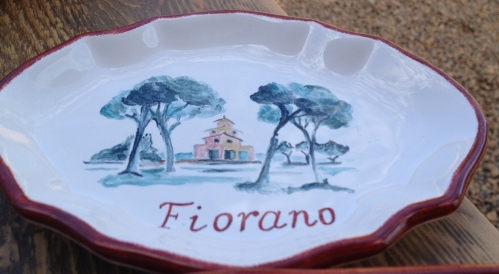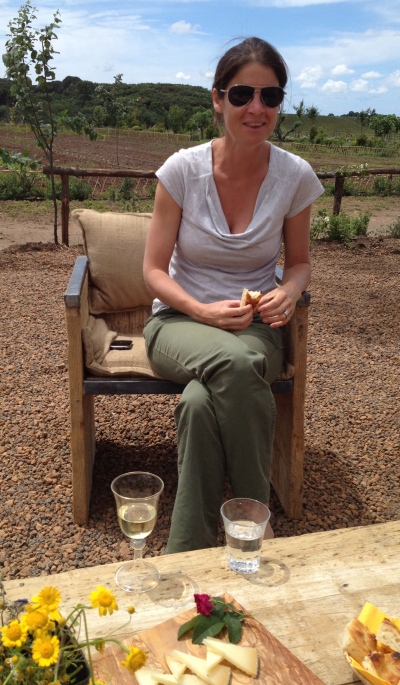When I visited Alessia had just began to restore the property and it looked like she had a long way to go
This year, Michele and I were in Rome once again and Alessia invited us to visit the winery and have lunch with her. The winery is across the road from Rome’s Ciampino airport just 20 minutes from the center of Rome by taxi (just 30 Euros — they now have fixed fares to the airports in Rome). Alessia picked us at the airport and in a few minutes we were at the winery
Alessia had done a lot of work since my previous visit. All of the buildings had been restored and the winery was up and running. The vineyards were all planted in orderly rows and there was a very large organic vegetable garden which we toured. Alessia’s grandfather had taken very good care of the land and believed in organic farming. Alessia said she was following in her grandfathers’ footsteps.
We sat down to lunch under the warm May sun; it was difficult to believe that we were so close to Rome. We discussed her plans for the winery and of course the wine.
She said that she has turned part of the property into a country retreat for Romans who want to leave Rome during the warmer months. They can come for lunch on Friday, Saturday and Sunday. She calls it Cucina Aperta. The guests can go to the vegetable garden and pick the vegetables that they want to eat and it will be prepared by the kitchen. So far it was all working out very well.
The soil at the estate is very special, Alessia said, volcanic with mineral salts and excellent for growing anything and grazing sheep. She said that the shepherds liked to bring their sheep there to graze and the sheep would become fatter and darker in color because of what they ate, and the dust from the soil would stick and make them almost black in color. Her grandfather grew wheat and was very fanatical about it. He cultivated a “mother” from the natural yeasts in the area in order to make his own bread.
The conversation turned to the wine and Alessia said that she wanted to make wine the way her grandfather did.
This was very good news to me since, as many of you know, Fiorano Rosso made by her grandfather may well be my favorite red wine. Alessia said that there were 14 hectares planted with vines: Cabernet Sauvignon, Cabernet Franc, Merlot, Semillon and Malvasia del Lazio. They are divided by hectares and the Cabernet Sauvignon, Merlot and Semillon are vines which come from a “massal’ selection (propagation) from the old vines. There are four rows of Cabernet Sauvignon and four rows of Merlot of the “old vines” (Vigna Storica vines more that 40 years old). As for the historic Semillon, she said that they were supplied to her by “the brother of my grandfather’s assistant who lives on the estate and still has a few rows.”
Among these old vines were some plantings of Cabernet Franc, which Alessia thinks her grandfather used for the Fiorano, but is not 100% sure. The 2010, 2011 and 2012 Fiorano Rosso vintages were vinified at her father (Piero Antinori’s) estate in Umbria. The 2013 is the first vintage to be vinified here. The 2010 (800 bottles produced) will not be released until 2014 or 2015.
With the excellent lunch we drank Fioranello a lively, fresh red wine made from young vines that went very well with the food. Alessia referred to this as her second label.
Up until now they are using different barrels including tonneaux to vinify and age the wine because they do not have enough wine to fill a large cask or a concrete tank.
This year the Fioranello was vinified in two concrete tanks and aged in two medium sized casks. The Fiorano made from the Vigna Storica was aged this year in tonneaux for reasons of space. All of this may change in the future. Alessia, by her passion for her grandfather’s estate and the wine that he produced made it clear that this was her project and she would be the one involved in all aspects of it. I look forward to tasting and drinking Alessia’s first vintage of Fiorano rosso.









